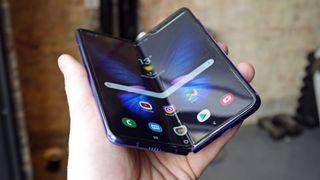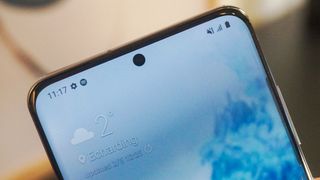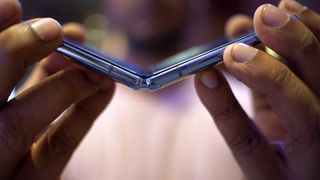What the Samsung Galaxy Z Flip can tell us about the Galaxy Fold 2
Passing the folding baton

The Samsung Galaxy Z Flip was shown off at Samsung Unpacked in February alongside the Galaxy S20, taking up the foldable slot that the original Galaxy Fold took up the year before, and there was no sign of that phone’s rumored successor, the Galaxy Fold 2.
We’re still expecting a Samsung Galaxy Fold 2 though, with a similar form factor to the original but with a collection of improvements and new features to make it a high-flying top-end foldable phone.
We’re still a way off from its anticipated launch (we’re thinking August now alongside the Galaxy Note 20), and there hasn’t been much in the way of leaks and rumors so far, but we can instead look to the Samsung Galaxy Z Flip to show us some of the changes Samsung might make for the Galaxy Fold 2.
Super-size me

One of the most important reasons for foldable phones existing is to make devices more compact and portable, since they shrink down when folded. That includes both tablet-sized phones that can reduce to a reasonable size in your pocket, and normal-sized phones that can get tiny when folded.
The Samsung Galaxy Z Flip fills this latter need, so Samsung has already covered that base, and now it just needs a phone for the former. The original Galaxy Fold was this to an extent, but when closed the phone was smaller - or at least narrower - than your average handset.
Samsung could, therefore, bump up the sizes somewhat to have a super-sized tablet that closes down into a fairly large (but not unwieldy) phone.
This would deliver on the promise of the original Galaxy Fold, of a smartphone that opens into a tablet, but turning the sizes up to really deliver that big screen experience.
Get daily insight, inspiration and deals in your inbox
Get the hottest deals available in your inbox plus news, reviews, opinion, analysis and more from the TechRadar team.
Functional when folded

One of the touted features of the Samsung Galaxy Z Flip was the Flex Mode, which allows you to half fold the device to a right angle, place it down on a surface, and interact with some apps and functions in different ways.
For example, the horizontal part of the screen functions like a trackpad in the gallery, while in YouTube this part of the screen will display comments, while the video plays on the other half. This also allows the phone to function as a handy tripod when taking photos.
That makes it seem like Samsung views using the phone while semi-folded as an important part of the experience, and a way to bring out features and functions that you wouldn’t otherwise be able to use.
Since the Samsung Galaxy Fold 2 will fold in a different way to the Galaxy Z Flip (if it retains the original’s form factor) we could see a new host of semi-folded functions: perhaps another photo mode, or a gaming function, or a different way to watch content.
Punch-hole front camera

When the Samsung Galaxy S10 came out with its punch-hole camera, Samsung stated it wasn’t looking to stick with the design feature for that long, but all of its top-end phones in 2019 and 2020 used it, including the Galaxy Note 10, Galaxy S20 and Galaxy Z Flip.
It seems, then, that the Samsung Galaxy Fold 2 will likely also have a punch-hole snapper on the front, to reduce the amount of screen real estate the lens takes up. We’ve heard rumors the device will have an under-display camera, but frankly, that doesn’t seem likely since this tech hasn’t been in any released smartphone so far.
There could be multiple front-facing cameras, but we’d expect them all to be in cut-out sections, probably right next to each other.
An Ultra-Thin display

One of the most touted features of the Samsung Galaxy Z Flip was its 'Ultra-Thin Glass' display - a thin, foldable glass screen. That's in contrast to previous foldables - including the Galaxy Fold - which used plastic screens. The move to glass is notable as it's theoretically a lot tougher than a plastic screen.
That said, later durability tests suggested that Ultra-Thin Glass contains a lot less glass than you’d expect, but it is still an important aspect of the device.
In contrast, Samsung stayed very mum about the Galaxy Fold’s plastic display, partly because it kept breaking. The Z Flip’s display doesn’t seem to break nearly as much (though it's still likely less hardy than a typical smartphone), so it seems Ultra-Thin Glass is a success in Samsung’s books.
Therefore we’d expect future Samsung foldables, including the Galaxy Fold 2, to make the most of this display technology. We’re glad of that too, as the Z Flip feels sturdy to use and you never feel like you could accidentally punch through the screen.

Tom Bedford was deputy phones editor on TechRadar until late 2022, having worked his way up from staff writer. Though he specialized in phones and tablets, he also took on other tech like electric scooters, smartwatches, fitness, mobile gaming and more. He is based in London, UK and now works for the entertainment site What To Watch.
He graduated in American Literature and Creative Writing from the University of East Anglia. Prior to working on TechRadar, he freelanced in tech, gaming and entertainment, and also spent many years working as a mixologist. He also currently works in film as a screenwriter, director and producer.
Most Popular
